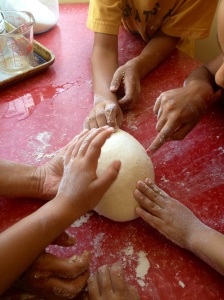I’m not big on micromanagement. As long as the kids aren’t in danger of hurting themselves or others, I generally let them be. However, with the prospect of several children working in tight quarters around hot sheet pans, an old Wedgewood stove and an open flame, I thought a discussion of kitchen guidelines might be prudent.
At our first gathering we talked about three rules that we would need to remember each time we worked together, and most importantly, each time they cooked or baked at home.
As always, number one is work safe. I invoked the infamous “walking feet” rule. This was promptly followed by the “mindful hands” rule. More specifically, grabbing, reaching over others and mindless flailing of arms may get someone burned.
The second is work clean. The obvious answer to my “what does that mean?”, was an encouraging “wash hands!” We then discussed keeping hands away from mouths and noses which prompted several of the kids to run off to the bathroom to rewash. The second part of this rule is “clean as you go.” Wiping up spills and moving dirty items out of the way keeps one from trailing goo about the kitchen and keeps slipping hazards to a minimum.
The last is work smart. Quizzical looks followed. I explained about setting up a work space with everything needed for that project. Then I got all fancy with the French. Mis en place. Putting in place. “But how do I know which ingredients and what equipment I’m going to need?”, I asked. “The recipe!”, one cried. And with that, we were on our way.

